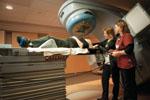
With the uncertainties posed by government’s evolving role in healthcare plus financial difficulties owing to the recession, the past year has not been easy for radiology centers trying to maintain a high level of patient care and make improvements in technology. Yet despite the challenges, there are numerous facilities that not only are persevering, but also making improvements to raise themselves to a higher level, both in terms of patient care and workflow efficiencies. This feature presents a brief look at three centers in different areas of the country that have undertaken numerous improvement projects during the past year.
They describe their activities in terms of four key areas:
Innovation: What they have done in the past 12 months, including changes in imaging modalities and IT technology to screen, diagnose and recommend treatment or to optimize patient care.
Operational Efficiency: Efforts to achieve operational efficiencies, such as streamlining workflow or increasing patient throughput.
Patient Service: What was done to increase patient comfort, emotional well-being and satisfaction in areas like paperwork and wait-time.
Teamwork: Efforts undertaken to create a sense of teamwork among staff members, working together to make the facility a successful venture.
ITN congratulates these three facilities for their hard work and achievements during the past year.
Exempla Saint Joseph Hospital, Department of Radiation Oncology, Denver, Colo.
Innovation: This was an important year for the oncology program at Exempla Saint Joseph Hospital (ESJH), which is governed by Exempla Healthcare and Sisters of Charity of Leavenworth Health System (SCLHS). It is among the top three Colorado hospitals for newly diagnosed cancer cases. To meet its needs, the Comprehensive Cancer Center brought together the Breast Care Center, cancer psychosocial services, genetic counseling, medical oncology, surgical oncology, a laboratory, a research department, a new cancer pharmacy and the Infusion Center. This gave related professionals access to leading-edge technology and the ability to interact to provide coordinated care to each patient. An oncology electronic medical record (EMR) was adopted to streamline workflow.
Part of ESJH’s mission was to replace outdated technology, add new technology, upgrade treatment planning software and add high dose rate brachytherapy. Mark Chidel, M.D., medical director, radiation oncology, championed implementation, along with physician partners. Radiotherapy treatments using Varian Medical System’s Trilogy were implemented last year, adding image-guided radiation therapy (IGRT), stereotactic radiosurgery (SRS), stereotactic body radiotherapy (SBRT) and volumetric modulated arc therapy (VMAT). The department not only met its initial anticipated treatment volumes of SRS (frame-based, frameless) and SBRT, but surpassed them by 75 percent. The high dose rate brachytherapy program was implemented in September. Also in September, a Varian TrueBeam was acquired. ESJH became the first multivendor site in the United States to implement treatment on the TrueBeam.
Operational Efficiency: The medical physics team collaborated closely with radiology magnetic resonance imaging (MRI) and positron emission tomography/computed tomography (PET/CT) staff to implement imaging in the radiation oncology setting. Dramatic clinical benefits were realized with the implementation of VMAT techniques, including increased accuracy, reduced treatment time and improved patient flow and workflow. With the TrueBeam, the department began planning the vast majority of patients receiving intensity-modulated radiation therapy (IMRT) treatments with VMAT planning. It realized a 25 percent increase in IMRT treatment techniques. In addition, the oncology service line’s Mosaiq EMR was further optimized to track clinical activities and use of patient data. Planning forms and order sets were organized to individual patient planning sessions. Quality checklists and document approvals were used to track and sign off on tasks and patient documents. All dosimetry and physics treatment planning were formatted for electronic export into the patient’s EMR.
Patient Service: The Comprehensive Cancer Center provides leadership, assessment, planning, evaluation and improvement of all cancer-related services offered to patients and their families. A Multidisciplinary Cancer Committee and tumor boards include physicians from surgery, medical oncology, radiation oncology, diagnostic radiology and pathology. Allied health members include representatives from hospital administration, nursing, case management, quality development, cancer registry, research and psychotherapy. Patients have many psychosocial support services, beginning with online access of the Comprehensive Cancer Center’s Patient Workbook, weekly distress screening by the psychosocial team during treatment visits with the radiation oncologists, a nutritionist who educates and facilitates the nutritional plan of care and new patient orientation.
Teamwork: The technologic acquisitions/implementations were successful largely because of the shared values within the radiation oncology treatment team. There were “champions” in all projects working together throughout the multiple projects. ESJH experienced decreased turnaround time from request for consult to consult to treatment planning, as well as increased overall efficiencies. Current activities include the building of a radiation oncology Website, and the radiation oncology information in the Comprehensive Cancer Center Patient Workbook is being rewritten.
First Coast Oncology, Jacksonville, Fla.
Innovation: First Coast Oncology has been in existence for more than 20 years. In the past year, Scot Ackerman, M.D., made tremendous improvements and innovations for his two facilities. He renovated the 6,000-square-foot facility into a 20,000-square-foot tranquil environment, designed by Drake Design of New York and showcased in Interior Design. First Coast took a paper chart department and transitioned to a fully electronic (paperless) medical record (Impac) and it added the first CRad Sentinal system in the United States. It assisted with the development and implementation of its external patient surface, real-time monitoring system.
First Coast added positron emission mammography (PEM) and pioneered the first system in the world to localize and place Accuboost treatments using PEM localization. It successfully introduced Accuboost high dose rate (HDR) treatment as an option for breast cancer patients. It expanded its technology to include a new Elekta Synergy Accelerator with XVI cone beam computed tomography (CT) and portal imaging. This technology, coupled with Calypso real-time tracking, tracks and manages prostate anatomy, as well as surrounding normal tissue, for better targeting.
First Coast also provides: external beam treatment, including 2-D, 3-D and IMRT; stereotactic radiosurgery; Nucletron HDR treatments, including interstitial, intracavitary, plaque, Mammosite, Accuboost and Valencia Surface applicators; PET/CT simulation and diagnostic PET/CT onsite; radiopharmaceutical treatments; Calypso real-time patient monitoring; Exactrac IGRT; Theraview portal imaging; and Pinnacle, Brainlab and Nucletron treatment planning with PET/CT and MRI fusion. More technology additions are planned for the future.
First Coast has contracted with Still River Systems to install a Monarch 250 proton facility at its Jacksonville location. It will be among the first in the country to install and implement the newest innovation proton technology.
Operational Efficiency: First Coast designed its new facility to better handle patient flow, with convenient exam and changing room locations with lockers to enhance patient’s readiness for treatment. It placed sub-waiting areas to increase patient comfort and readiness. The company considers its EMR system as one of its greatest accomplishments. A patient’s complete record is easily accessible from any location at any time.
This increases the knowledge base of all personnel involved in a patient’s treatment and allows for instant peer review and coordination of service. In addition, the incorporation of IGRT and real-time patient monitoring reduced set-up times and increased accuracy in delivery.
Patient Service: In the new addition’s design process, every care was taken to increase patients’ comfort and ease anxiety. It was constructed in an environmentally friendly philosophy, using skylights and natural light plus automatic lighting and temperature control in all areas. Exam rooms view outside landscaping and a lake and a sound system plays relaxing music throughout the building.
First Coast says its greatest achievement is the relationship physicians and staff have with patients. Its patient satisfaction ratings are consistently “A.” It provides patients with support services and education to assist them throughout their cancer journey. A licensed clinical social worker provides a variety of services for free, including: counseling; transportation concerns; advance directives; resource referral; bereavement services; genetic testing; and assistance with the financial strain.
The center also offers several support programs to the local community. These include Man to Man, a monthly educational group for men with prostate cancer, and Journey to Survival, which helps newly diagnosed patients cope. Cancer survivors are invited to a special program, Celebration for Survival, twice a year to learn about keeping healthy after cancer treatments, recommended follow-up care and to see their medical staff again.
Teamwork: The radiation oncology team made the difference in the success of the recent changes, thanks to each individual’s acceptance. One outcome was implementation of the EMR and treatment verification system in less than six months, a significant feat.
Southwest General Hospital, Middleburg Heights, Ohio
Innovation: The radiation department was recently renovated and a TomoTherapy unit installed. Southwest General Hospital specializes in cancers of the head and neck, with a multidisciplinary team approach. This center is hospital-based and partnered with the University Hospital’s Ireland Cancer Center, a National Cancer Institute-designated cancer center.
Operational Efficiency: The cancer center’s infusion area has been operational with electronic medical records for more than six months. The online documentation makes it easy for all disciplines, departments and outside physician practices to view nursing notes, patient education and medication administration records. The center just implemented an integrated scheduling system to allow other departments to view the patient schedule and appointments.
Patient Service: There is a dietician certified in oncology nutrition and a social worker in the department. These disciplines meet with each new patient or by referral. If the waiting time is long, the center offers pagers to patients so they can attend another appointment on campus or go to the gift shop or cafeteria, if they wish. Complimentary coffee, tea and water are available and boxed lunches are offered to patients who stay over the lunch hour. There is a library with a computer run by volunteers and there is a chemotherapy class for all first-timers.
Teamwork: The manager’s office is in the department and the door is always open. Staff members have an open relationship and good gallup scores. The average tenure of the nursing staff in the department is 18 years. For the past four years, the department has held an annual staff/patient softball game and potluck picnic. This is a great time for staff to mingle with the patients and their own families.



 December 16, 2025
December 16, 2025 









